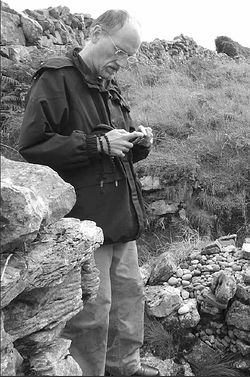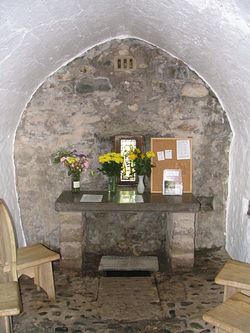It was while reading Zoology at the University of Wales, Native Welshman Howard Huws acquired an interest in Welsh history and literature. After working for the Welsh Water Authority in finance, hydrology, chemistry, fisheries and flood defense, he is now a Welsh/English translator for the Environment Agency Wales.
After a childhood in various Congregationalist/Anglican parishes, and a period of searching, Howard attended his first Orthodox liturgy in 1987 with Archimandrite Deiniol of Church of the Holy Protection in Blaenau Ffestiniog, Wales: “It was quite unlike anything I’d attended before: long, rhythmical, and elaborate, with icons, incense, and people either standing or kneeling. That was it: after years of prospecting, I’d hit the lode. It was time to stop searching, and start digging, and the wonderful thing is, the deeper one goes, the brighter and wider it gets.”
Howard’s interest in holy wells arose from both Orthodoxy and an interest in local history: “It’s an increasingly popular subject, and in Wales we’re fortunate enough to have at least two societies dedicated to the finding, recording and restoration of holy wells. I’m the Chairman of the Welsh one, Cymdeithas Ffynhonnau Cymru, mainly active in the north and west. I enjoy the challenge of researching the subject, and being able to share information and values with others. Whenever I’m on pilgrimage, I look for more wells and sources, and am seldom disappointed.”
* * *
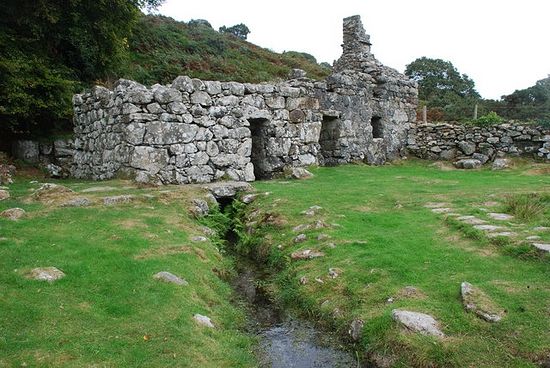 Ffynnon Gybi Llangybi, St Cybi's Well The water from the well flows out of the well building. Photo: Alan Fryer.
Ffynnon Gybi Llangybi, St Cybi's Well The water from the well flows out of the well building. Photo: Alan Fryer.
Fresh water is essential for earthly existence, but heavy. Carrying it in quantity requires considerable time and effort, and any settlement, however temporary, must have a dependable supply close at hand. Our ancestors particularly valued reliable, copious wells and springs untainted in smell and taste, and free of ill-effects.
When did this dependence give rise to reverence? We don’t know. Waters present in otherwise arid environments or manifesting inexplicable phenomena (erratic flow, heat, relief of infirmity, or the presence of other liquids resembling blood, oil, or milk[2]) would surely have occasioned thought: but we know very little in Wales about the beliefs of our pre-Christian ancestors.[3]
We’re on safer ground in stating that the archaeological record indicates a significant climatic deterioration during the Mid-Bronze Age, about 1100–1000 BC. This coincides with an increased tendency to place items of value in lakes, rivers and bogs.[4] It’s tempting to conjecture that these were offerings to spirits or gods, as the old sacred network of stone circles, henges and pits was abandoned in favour of the watery portals of an otherworld whose forces were obviously gaining the upper hand on those of sunny sky and dry earth. Such relics may, however, have been as much (or more) a means of marking territorial boundaries in an age of heightened conflict, as agricultural land became increasingly waterlogged and unproductive.
This impulse to place valuables in water was strong enough to cause the deposition of large amounts, and the building of elaborate wooden piers to facilitate the practice. All manner of gear found its way into the waters, but the most popular, by far, were swords, spearheads and axe heads, very often bent, broken or otherwise rendered useless to man beforehand.[5] This wasn’t scrap metal: the objects had been in good condition, and even fresh from the mould, before being deliberately spoilt and deposited. So why throw them away? Possibly as a rite of devotion, and a means of removing surplus bronze from circulation. This would increase its scarcity, maintain the value of what remained, and thus confirm and boost the social status of whoever could afford to throw it away: members of a warrior caste, judging by the predominance of weapons. Our culture, alas, is still one which lends prestige to such conspicuously unproductive use of resources.[6]
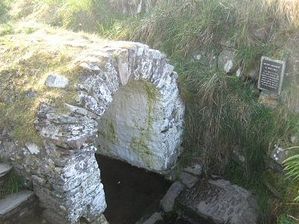 St. Non's well.
St. Non's well.
To sum: such wells (however few) were part of the environment into which the first Christians arrived, but we don’t know how they were regarded, or how active was any cult connected with them, by that time. Despite that, it has been claimed for the past century and more that all Christian holy wells are but pagan sites renamed, or even that the saints themselves are but new versions of old deities.[9] This is an opinion that is not so much a reasoned conclusion as it is an expression of disenchantment with contemporary urban Western society.
Nonsense such as “ley lines” and “earth energy” aside, more plausible arguments for the survival of paganism at wells are open to question. To assume that the legend of the throwing of Excalibur into a lake is a “memory” of pagan practice is to fail to consider the possibility that it could be a much later response to the finding of magnificent ancient weapons in such places, long after the original reason for their being there had been forgotten. The bent pins placed in number in holy wells in Wales are, like those bronze swords of old, sharp metal objects rendered useless: but pins were uncommon here before the Industrial Revolution, and don’t seem to have been placed in our wells before that time.
Accumulations of white pebbles, such as are found at pre-Christian sites, have also been found at Welsh holy wells. They’re undeniably striking, and have been collected and used for ornament since we dwelt in caves: but again, there’s no evidence for their being cast into wells before the mediaeval period, and the only reason for that may have been that they were thought to look attractive.[10] We to this day crown walls and gateposts with white quartz, and strew it on graves, because it looks bright and clean, not for any other reason.[11]
Even assuming that these pins and pebbles manifested ancient tradition, such feeble continuity of practice doesn’t constitute continuity of worship, any more than the present habit of casting small change into ornamental fountains manifests conscious, active belief in water deities.[12]Of all the holy wells of Wales, not one gives evidence of continual worship across the pagan/Christian divide: and as far as I know, there is no historical record of any Welsh holy well being connected with ancient paganism, nor any archaeological find confirming such a connection.[13] There are no images, dedicatory inscriptions, or offerings, and no hard evidence for any supposed pagan “head cult” connected with wells.[14] Even throwing coins into water may be comparatively recent here, the habit having drifted in from elsewhere.[15]It could plausibly be no more than a debased form of the monetary offerings made at Christian shrines, including wells, before Protestantism got a firm grip here.[16]
Waters and Wells in Christian Wales
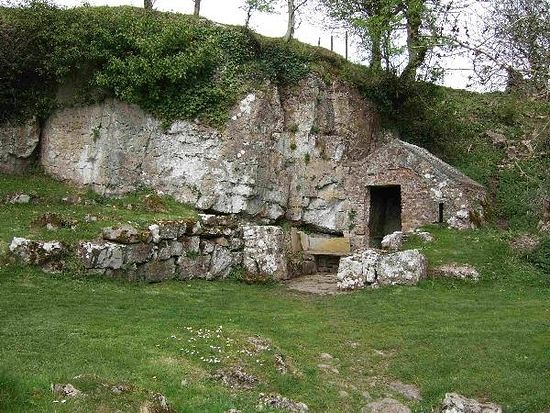 St. Seirol's cell and well.
St. Seirol's cell and well.
Indeed, those early Christians arriving here from the East, or under the influence of Eastern movements such as monasticism, would already have been familiar with holy wells, such as that at the great shrine of Abu Mena in Egypt.[17] Had they found Britain and Ireland devoid of sacred wells and founts, they would have had to consecrate many for their own use:[18] and in so doing, would recall scriptural precedents. As the Children of Israel walked dryshod through the Red Sea, so the Thames parts before Alban the Martyr.[19] As Moses struck water from the rock, so it gushes forth when St Cadog of Llancarfan strikes his crozier into the ground.[20]
This isn’t merely the translocation of stories from one place to another. In passing through the waters, the thousand Britons accompanying Alban undergo baptism into new life, and the nation becomes Christian. That the very waters now obey God’s servants shows that the land itself is explicitly and recognizably His. It is a Christian country populated by a Christian people, whose primary response to the miracles of hot springs, healing wells and suchlike wonders is to stand in great awe of God’s wisdom, power and mercy in supplying such blessings, such pools of Grace. This sense of awe and gratitude runs deep, and has not left us. It finds expression in prayers and invocations, in rites and pilgrimages, in song and story, and in the willing dedication of wealth, time and labour to the glory of God and the benefit of others. Even when waters express the dark forces of a fallen world, in raging torrents and devastating floods, a saintly prayer or gesture tames them immediately: the elements obey their Creator.
Welsh wells may be regarded as “holy” insofar as they’re dedicated to God in the name (or in memory) of a saint, feast day, or other explicit manifestation of Christanity (e.g. the Holy Cross). The well’s name usually manifests this holiness, or an intimate connection with a nearby Christian shrine. Most holy wells here bear the names of Welsh saints, some of whom have many dedications elsewhere in the British Isles and nearby continental Europe. Comparatively few are dedicated to other saints such as George, Anthony and Michael, but I’d hesitate to ascribe all such to the desire of incoming Norman or Anglo-Norman elites to leave their stamp on the spiritual landscape, however strong that may have been.
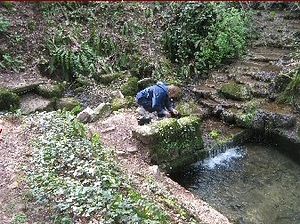 St. Dyfnog's well.
St. Dyfnog's well.
Certain wells were reputed to be particularly efficacious in the healing of specific ailments. To take a few examples from Anglesey alone, supplication at Ffynnon Faelog was said to cure rheumatism; Ffynnon Wenfaen, depression; Ffynnon Gybi (Holyhead), rheumatism, scurvy, and scrofula; and Ffynnon Badrig, rheumatism, weak eyesight, stomach ailments, gout, boils and toothache.[22] Judging by frequency and distribution, certain complaints seem to have been either particularly amenable to such treatment, or very widespread and troublesome: rheumatism, sore eyes, and warts, to name but three. As professional doctors were widely distrusted (not without reason) and expensive, the change of environment, physical exercise and camaraderie involved in pilgrimage, or at least a change of drinking water, may have been as good a treatment as any available at the time, and faith in God’s goodwill was certainly essential to the healing process.
One also finds wells whose waters were said to cure and safeguard livestock, including cattle, sheep and horses. God’s healing Grace extends to all of Creation, not mankind alone.[23]Others are now simply regarded as “lucky” or wholesome; but without a specifically Christian dedication, they’re no longer thought of as being holy. It may be that some were once so dedicated, but that the spiritual tradition was broken or forgotten in the confusion of the Protestant Reformation and the subsequent centuries of discouragement and neglect.[24]
Wells could be visited at any time of year, but some were held to be particularly efficacious on certain feast days, or at times of day or times of year. At some, prayer and the drinking of water was sufficient. At others, rituals were observed: some as simple as the pricking of a wart with a pin which was then bent and cast into the water, others highly elaborate, involving visiting the well on a certain day of the week, the recitation of prayers, perambulation, offering money, sleeping at a nearby shrine, or drinking from a specific vessel.
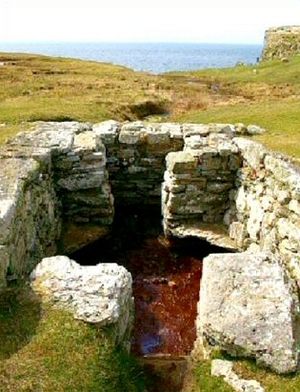 St Gwenfaen's Holy Well.
St Gwenfaen's Holy Well.
The belief that certain wells had divinatory powers may have evolved from rituals of healing. At Ffynnon Gybi (Llangybi Eifionydd), for instance, those seeking to improve their health would stand barelegged in the water: and should the resident eel appear, and coil itself about the patient’s legs, it was believed that a cure would follow. At others, an answer to queries was provided by the appearance of fishes, or the movements of handkerchiefs, breadcrumbs or feathers placed on the surface of the waters, interpreted by a “seer”.[26] Saint Dwynwen’s well at Llanddwyn, for instance, was much resorted to by lovers seeking reassurance or forewarning regarding their relationships, good news or otherwise being indicated by the direction of drift of a handkerchief spread on the water. At some wells, the aid of saints was invoked in the detection of thieves; and with the decline of spirituality into superstition, this practice became perverted into a strong belief that one or two wells had malignant powers, and could be used for cursing enemies: a practice which persisted into the 1920’s.[27]
The Desecration of Splendid Shrines
The mortar had barely dried on some of the more splendid shrines than they came tumbling down, for the cataclysm of the Protestant Reformation didn’t spare holy wells. Their structures were desecrated, anything of financial value stripped out, and offerings and pilgrimages strictly forbidden.[28]
This often proved difficult to enforce, especially where magistrates proved less than eager. Pilgrims in number were still visiting Ffynnon Wyddfaen in Carmarthenshire as late as 1595, and John Lewis of Ceredigion, writing in 1646, implies that pilgrimages to wells were still current at that time.[29]
I doubt if many wells were completely destroyed, for dependable water sources were still of value, if only for keeping butter cool: and neither harsh laws nor sophisticated scorn succeeded in erasing the belief that certain founts are holy, and can heal disease or otherwise improve the lot of those who with due reverence drink of them or wash in them. Where the powerful feared or disdained to be associated with wells, the poor, here and there, kept the traditions alive until this very day.
Since the 16th century, more wells have been lost through neglect and thoughtlessness than ever fell foul of overt iconoclasm. Those no longer sites of devotion or healing were allowed to silt up, drained or filled in for one reason or another, destroyed in the course of some purported improvement, or simply forgotten. St Chad’s Well at Hanmer ceased to flow after local drainage work; St Deiniol’s Well at Bangor lies under quarry rubble; St Cybi’s Well at Clorach vanished under a road bridge, and St Gredifael’s Well at Penmynydd is a muddy hollow. The list is too long, and the baleful influence of Calvinism, which prevailed in Wales from the mid-18th century until recently, certainly provided an environment in which such desecration could be countenanced: but even following the decline of that grim doctrine, sheer ignorance and apathy still threaten what remains of our holy inheritance. One has always to be on guard against the threat posed by the next road improvement scheme, or the incoming houseowner who decides that the old spring in his garden should be concreted over.
Restored Hope, Recovered Pilgrimage
All, thank God, is not lost. The rise of antiquarianism in the 19th century certainly raised awareness of the presence and significance of holy wells, if only from an historical point of view. This coincided with an increasing interest in sacramentalism and the spiritual inheritance in general, and the fact that Roman Catholicism was no longer considered a political threat. The 20th century saw a renewal of interest in, and devotion at, holy wells: with the result that their sites have been diligently recorded, and attempts made—some very successful—to rescue them from oblivion, safeguard their existence and restore them to use. This is hard work, but inspired individuals, community groups, local government bodies and societies such as Cymdeithas Ffynhonnau Cymru and Wellsprings have achieved much in this endeavour. It has also been observed that a restored well once again attracts people in need of comfort, hope and spiritual refreshment. One notable manifestation of this increase has been the renewal of supplication at St Trillo’s Well at Llandrillo-yn-Rhos (anglice Rhos-on-Sea). This tiny chapel, built above an accessible holy well, stands on the very seashore, and is generally open to the public. During the past few years, people have taken to placing numerous written requests, prayers asking for help or forgiveness, on the altar.[30] Why this should have happened there, and whether the practice is spontaneous or has originated elsewhere, nobody knows: but it does show that the Spirit still hovers about the waters, surprising and inspiring us with something beyond our dry intellectual musings.
Yes, holy wells are still prominent features of the Welsh spiritual landscape: and by the power of God manifested in them, may they once again refresh, heal and adorn this country, aiding the restoration unto Orthodoxy of a Christian land of a Christian people.
Troparion of All Saints of Wales, Tone 8.
The land of Wales doth offer Thee, O Lord, All the saints which have shone forth in it, As the beauteous fruits of Thy saving splendour. By their prayers and through the Mother of God, Preserve Thou the Church and our land in peace profound, O Most Merciful One.
[1]Francis Jones’ pioneering study, The Holy Wells of Wales (Cardiff: University of Wales Press, 1954) lists over a thousand: but his definition of “holy” was very liberal, and though he had access to the contents of the National Library of Wales, questions have been raised about the amount of fieldwork he undertook.
[2]Bord, J. and C. Sacred Waters, p. 83. Granada, London 1985.
[3]Works such as Anne Ross’ Pagan Celtic Britain make remarkable assertions, but their factual basis has been called into question.
[4]Pearson, M. P. Bronze Age Britain. B. T. Batsford Ltd / English Heritage, London 1993.
[5]Is there an Orthodox critique of Thorstein Veblen’s The Theory of the Leisure Class?
[6]Not into wells, though. See Lovegrove, C. “Wishing Wells and Votive Offerings”, at http://people.bath. ac.uk/liskmj/living-spring/sourcearchive/fs8/fs8cl1.htm. To quote: “...wells seem not to have attracted the ostentatious wealth that lakes and rivers have. It may be that wells, as the beginnings of rivers, need only to receive tokens, such as coins, whereas the treasure found in larger bodies of water represent the fulfillment of vows in thanksgiving for wishes coming true...”. Perhaps wells simply didn’t allow space enough for an impressive offering, or were so valued for potability as to rule out any tainting, however well-intentioned: or simply weren’t regarded as “sacred”.
[7]Fox, Cyril. A find of the Early Iron Age from Llyn Cerrig Bach, Anglesey. Cardiff: National Museum of Wales, 1946. Green, Dr. Miranda. The Religious Symbolism of Llyn Cerrig Bach and other Early Sacred Water Sites. Source, New Series 1, Autumn 1993.
[8]At Bath (Aquae Sulis), for example. Even so, such sites are very few.
[9]St Bridget of Kildare and St Non of Wales, for instance, are sometimes proclaimed to have been pagan goddesses, despite all evidence to the contrary.
[10]When all’s said, if one really wants to throw objects into a well, the choice is pretty limited, and reveals little of the reason for doing so. White pebbles were still being so cast until the 18th century, if not later. At Llandegla, the practice seems to have given way in the early 19th century to the offering of coins. (see note 14).
[11]I’ve seen gardens and gateposts in Antrim decorated with sections of hexagonal black basalt columns, and likewise mottled sandstone on the Gower Peninsula: it’s simply a matter of what’s available, and no-one (yet) imputes any other significance to the practice.
[12]They’re even thrown into the penguin pool at Bristol Zoo. The report and conclusions of future archaeological investigation of the site should make interesting reading.
[13]To date, few Welsh holy wells have been archaeologically excavated, and those that have (e.g. Ffynnon Degla at Llandegla; ffynnon Seiriol at Penmon, and Ffynnon Feuno at Aberffraw) have revealed little of note other than a layer of white quartz and calcite pebbles at Llandegla.
[14]The Roman well at Odell, Oxfordsire, however, had a human skull deliberately inserted into its lining, and the Roman-British well shrine at Springhead, Kent had the bodies of four infants built into its fabric, two of whom had been decapitated. See Rattue, James: Holy Wells and Headless Saints, at http://people. bath.ac.uk/liskmj/living-spring/sourcearchive/ns5/ns5jr1.htm. The healing rite practiced at Ffynnon Deilo, Llandeilo Llwydiarth, involved drinking the well’s water from a human skull, believed to be that of St Teilo. See also, however, T. G. Hulse’s article, “St Teilo and the Head Cult”, in Source, New Series 2, Winter 1994. In pouring cold water (so to speak) on the alleged pagan “head cult” connected with wells, Hulse discusses a wholly Christian eyewitness account, from mediaeval Wales, of healing through drinking water containing earth taken from this same saint’s skull. Following many adventures, including a sojourn in Australia, it’s now housed in a reliquary at Llandaff Cathedral, near Cardiff. That the practice of drinking from a skull was not confined to sacred relics is suggested by the similar use of a mediaeval nobleman’s cranium at Dolgellau, Gwynedd in the hope of curing whooping cough (see Jones, francis, op. cit.).
[15] For a possible example of such “drift”, see the account of St Trillo’s well below.
[16] As at Ffynnon Bheris, Llanberis; Ffynnon Eilian, Llaneilian etc. An ode by the fifteenth-century poet Hywel Rheinallt mentions offering a bent coin at the grave of St Cawdrdaf at Abererch. See also note 10 above as evidence that the casting of coins could be a comparatively recent habit.
[17]Evidence that Christians in Britain were familiar with Abu Mena, by direct experience or repute, is provided by a distinctive 6th–7th century ampulla found at Meols in the Wirral.
[18]. See Martin Martin’s “Description of the Western Isles of Scotland” (c.1695) for an account of such a consecration on the Isle of Eigg, Scotland.
[19] See Gildas, De Excidio (The Destruction of Britain). The river at St Albans is the Ver, not the Thames: but the latter is nearby, much more impressive, and in this context plainly meant by Gildas to symbolize Britain itself. No other river could adequately embody the whole country. In this, Gildas may also have been drawing upon Classical instances, such as the Scamander’s defence of Troy against Achilles.
[20] Jones, Francis, op. cit.
[21] Boorde, Andrew. The fyrst Boke of the Introduction of Knowledge, 1547.
[22] Gruffydd, Eirlys & Ken Lloyd. Ffynhonnau Cymru, Cyfrol 2. Llanrwst: Llyfrau Llafar Gwlad, 1999.
[23] Jones, Francis, op.cit. Horses, as vital in the past as petrol-driven vehicles are today, were blessed with well-water at Llansansiôr. This is the only church in Wales anciently dedicated in the name of St George, and the beliefs and rituals concerning the well underlines this saint’s particular association with horses. Perhaps this ultimately derives from Orthodox iconography.
[24] For instance, Ffynnon Sara (“Sarah’s Well”) at Derwen, Denbighshire, may not be unconnected with St Saeran, patron saint of nearby Llanynys. See Baring-Gould, S., and fisher, J. Lives of the British Saints, Vol. IV, p.130. Ffynnon Elan (“Elen’s Well”) at Dolwyddelan, Gwynedd, is more accurately named Ffynnon Wyddelan, St Gwyddelan’s Well. See Gruffydd, Eirlys & Ken Lloyd, op. cit. Rattue, on the other hand, warns against a tendency to ascribe sanctity to wells which were not considered “holy” in the past. See his The Living Stream: Holy Wells in Historical Context. Woodbridge: The Boydell Press, 1995.
[25] We may know more things than did our ancestors, but we’re no more intelligent.
[26] Jones, Francis, op.cit. The purported “seer” or “guardian” was usually no more than an aged resident who supplemented his or her meagre income in this fashion.
[27] See Gruffydd, Eirlys & Ken Lloyd, above. The most notorious such well by far was ffynnon Eilian at Llaneilian yn Rhos. The presence of the well was recorded in the late 17th century, with no mention of any malignant attributes; but by the mid-19th century (if not sooner) its alleged power to cause harm made it feared throughout north Wales. This ended when the “guardian” was jailed for fraud and the well filled in. Nothing daunted, the “cursing” function seems then to have shifted to Ffynnon Elian on Anglesey. A waxen image found nearby in 1925 may be seen in Bangor Museum, Gwynedd.
[28] At Capel Meugan in Pembrokeshire in 1592, for instance, government commissioners gave orders that: “…where somtyme offringes & superstitious pilgrimages have been used, and there to cause to be pulled down and utterlie defaced all reliques and monuments of that chappell, not leaving one stone thereof upon an other, & from tyme to tyme to cause to be apprehended all such persone and persones of what sexe kinde or sorte whatsoever that shall presume herafter contrarie to the tenor and p’rporte of the said honorable commission, to repair [go] either by night or daie to the said chappell or well in superstitious maner & to bring or send before us or enie of us…”
[29] In the case of Ffynnon Wyddfaen, the local magistrate did neither examine nor imprison them, later explaining to his superiors that they were “poor sickly persons” who had wished to wash at the well, “hoping by the help of God thereby to have their health”.
[30] A practice I’ve observed at an altar on Caldey Island, Pembrokeshire, and at the tomb of a Polish prelate in Cracow. Readers may know of other examples.
